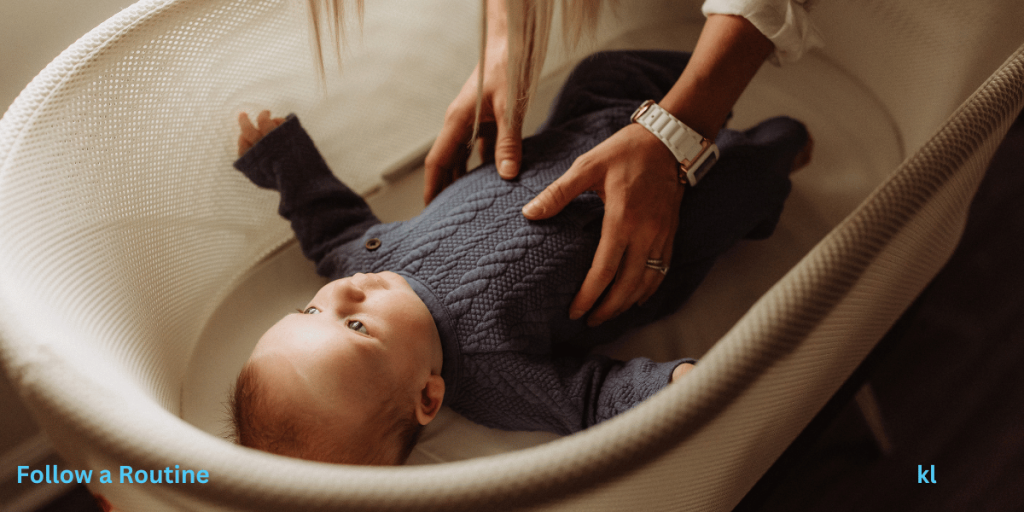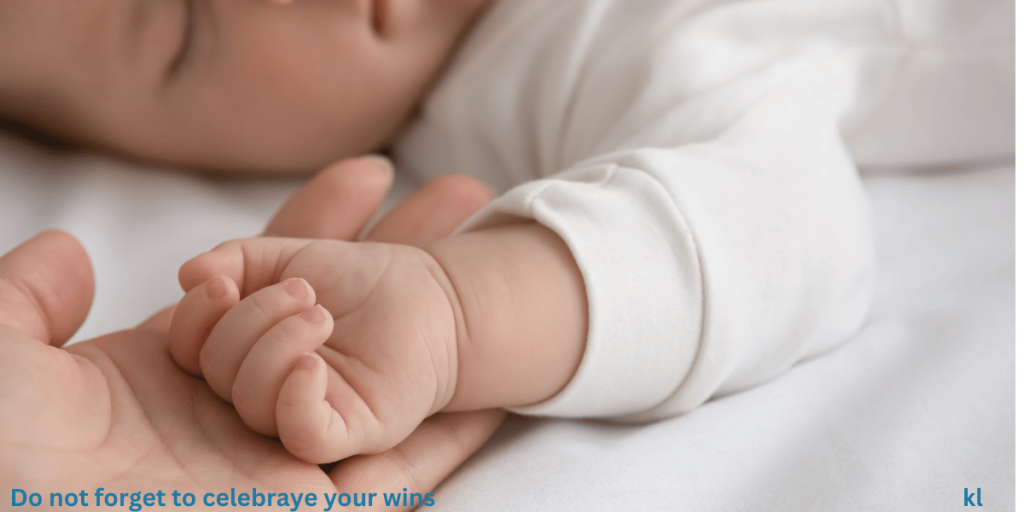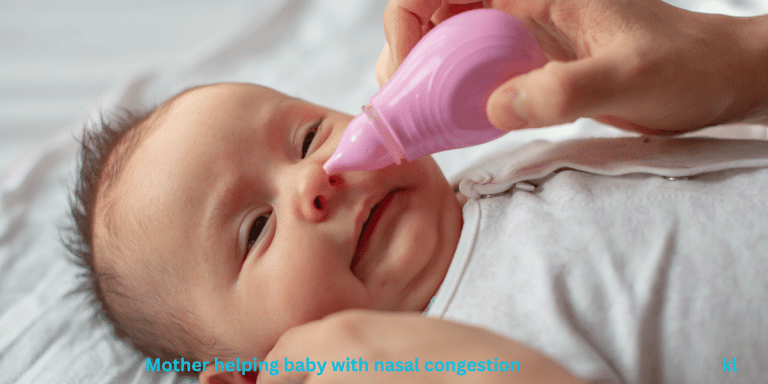Getting a newborn to sleep in a bassinet can feel like an impossible task. You lay them down, hoping for a few hours of rest, but within minutes, they’re fussing and crying. Sound familiar?
Many parents face this challenge, but the good news is that with a few small adjustments, you can help your baby feel comfortable and secure in their bassinet.
In this guide:7 Simple & Proven Tips for Helping Your Newborn Sleep in a Bassinet, I’ll share seven tried-and-true tips that have worked for real parents—so you can finally get some sleep too!
Create a Cozy and Safe Sleep Environment
Setting up a safe sleep environment for your newborn-ready home isn’t just about comfort—it’s about peace of mind.
I remember the first few nights after bringing my baby home, constantly checking to make sure she was breathing. Sound familiar?
I’d heard so much about bassinet sleeping problems that I almost drove myself crazy with worry. But once I learned a few key things, nighttime became much less stressful.
Keep the bassinet in a safe space
That means keeping the bassinet free from blankets, pillows, stuffed animals, or anything that could pose a suffocation risk. I know, I know—those Pinterest-worthy nursery photos with plush toys and adorable crib bumpers are tempting.
However, according to the National Library of Medicine (NLM), keeping the bassinet clear of these items significantly reduces the risk of Sudden Infant Death Syndrome (SIDS), making it a crucial step for safe sleep.
Safe sleep guidelines recommend a firm, breathable mattress with a fitted sheet—nothing else. It might not look as fancy, but your baby’s safety is worth more than aesthetics.
Temperature
Babies can’t regulate their body heat as we do, so overheating is a real concern. Experts recommend keeping the room temperature between 68-72°F.
I found that a simple room thermometer helped me maintain the right balance—if I was comfortable in light clothing, my baby probably was too.
Also, Keep the bassinet close to your bed, at least for the first few months. This setup made night wakings so much easier for me, and I didn’t have to stumble across the room half-asleep to check on my baby.
Plus, studies show that room-sharing (without bed-sharing)also reduces the risk of SIDS. Just make sure the bassinet is placed on a firm, flat surface and away from cords, curtains, or anything that could be a hazard.
At the end of the day, creating the perfect baby sleep environment is about balancing safety with comfort. Once I stopped overcomplicating things and focused on bassinet sleep solutions that actually worked, I felt way more confident. And guess what? My baby slept better, too.

Use the Right Swaddle or Sleep Sack
A swaddle was also a game-changer, mimicking the snug feeling of the womb while preventing loose blankets in the bassinet.
If your little one keeps breaking out of a swaddle, try a sleep sack instead—it’s a lifesaver. Trust me, figuring out what works best is all part of the baby care guide every parent builds along the way!
Choosing the Right Swaddle for Safety & Comfort
Not all swaddles are created equal, and safety is key. Here’s what to look for when picking the best one for your baby:
- Breathable fabric – Lightweight, breathable materials like cotton or muslin help prevent overheating.
- Proper fit – A swaddle should be snug around the arms but loose around the hips to allow for healthy hip development.
- Easy to use – Some babies wiggle out of traditional swaddle blankets, so a Velcro or zip-up swaddle might be a better choice.
Remember, the goal is to make your baby feel secure and comforted, like they’re back in the womb. But safety always comes first—swaddles should never cover the baby’s face or be too tight around the chest.
When to Transition to a Sleep Sack
Swaddling isn’t forever! Once your baby starts showing signs of rolling over, it’s time to switch to a sleep sack for safety. Rolling while swaddled can be dangerous since babies need their arms free to push themselves up.
Here’s how to make transitioning baby to bassinet and sleep sack easier:
- Start with one arm out – If your baby isn’t ready to go cold turkey, try swaddling with one arm out for a few nights before removing it completely.
- Introduce the sleep sack gradually – Let your baby wear the sleep sack for naps before using it overnight.
- Keep the rest of the routine the same – A familiar bedtime routine helps smooth the transition.
Swaddling is a lifesaver in those early weeks, but knowing when and how to transition out of it is just as important. With the right swaddle and a smooth shift to a sleep sack, your baby can continue sleeping safely and comfortably as they grow!

Establishing a Consistent Bedtime Routine
In the early days, I thought newborns just fell asleep when they were tired. Ha! I quickly learned that an overtired baby is a fussy, impossible-to-settle baby.
A predictable baby nighttime routine doesn’t have to be complicated. In fact, the simpler, the better. Think of it as a series of gentle cues: dimming the lights, a warm bath, a quiet feeding, and some soft lullabies.
I started with a short routine—just 10-15 minutes before bedtime—and slowly extended it as my baby got older.
This consistency helped set expectations, making the transition from active time to sleep time much smoother. At least I faced sleep regressions, but hey, we made it!
Timing is also key. Newborn sleep patterns can be all over the place, but most babies start showing signs of sleepiness around the same times each day.
I found that following my baby’s natural rhythms—watching for sleepy cues like eye rubbing, fussiness, or yawning—helped me figure out the perfect bedtime.
Experts say newborns should go down between 7-9 p.m., but honestly, every baby is different. The trick is sticking to the same general window each night so their internal clock starts to adjust.
Another game-changer? Keeping pre-sleep activities calm and predictable. I made the mistake of doing an exciting play session before bed once—bad idea! Babies need time to wind down, so I learned to avoid bright lights, loud noises, and stimulating toys at least 30 minutes before bed.
Instead, I leaned into quiet bonding time: gentle rocking, reading a short book, or even just humming while holding my baby close. These small moments helped cue my little one that it was time to transition into sleep mode.
Now, let’s talk about bassinet sleep. I made sure our bedtime routine ended in the same place every night—the bassinet.
I placed them down while drowsy but awake (which took some trial and error, to be honest), reinforcing that the bassinet was where sleep happened.
Building a solid baby sleep routine took patience, but once I stuck with it, I noticed a big difference. My baby fell asleep faster, stayed asleep longer, and bedtime felt way less chaotic.

Soothing Techniques for Bassinet Adaptation
Mimicking the Womb for Easier Adaptation
One of the biggest reasons babies resist the bassinet is because it feels too “big” and unfamiliar compared to the womb. Creating a womb-like environment helped my baby feel more at ease.
A white noise machine was at the top of my baby gear checklist—it helped recreate the familiar sounds from the womb. The heartbeat rhythms and gentle whooshing noises from it worked like magic to soothe my baby and promote better sleep.
I also made sure the room was dimly lit, using blackout curtains to create a cozy, sleep-friendly space. keeping things dark at night and bright during the day helped reinforce healthy baby sleep adaptation.
Gradual Transition Strategies That Worked
Instead of an abrupt switch, I found that a gradual transition to the bassinet was more effective. At first, I let my baby nap in the bassinet during the day while I stayed close.
This helped them get used to the space without the pressure of nighttime sleep.
Another trick? Warming the bassinet with a heating pad before placing my baby down (removing it before putting them in, of course!). This helped ease the transition from my warm arms to a cooler bassinet mattress, reducing wake-ups.
Using Familiar Scents and Textures for Comfort
Babies have a strong sense of smell, and my baby seemed to instantly know when they weren’t being held.
One thing that helped was placing a shirt I had worn (lightly scented with my skin’s natural smell) near the bassinet. It made the space feel more familiar and comforting.
I also paid close attention to textures. Some babies dislike the feel of the bassinet mattress because it’s firmer than what they’re used to.
A soft, breathable bassinet sheet made a difference in my baby’s sleep comfort.

Gentle Sleep Training Approaches for Newborns
Newborn sleep training doesn’t mean forcing strict sleep schedules or leaving a baby to cry. I found that gentle baby sleep coaching techniques worked best at this stage.
One approach I used was placing my baby in the bassinet when they were drowsy but not fully asleep. This helped them learn to settle without relying on me rocking them every time.
I also used a gentle touch to reassure my baby without picking them up immediately. It wasn’t an overnight fix, but with patience, my baby started to feel more comfortable in their bassinet.
Follow the “Drowsy but Awake” Method
Instead of rocking your baby to a deep sleep and then transferring them, you put them down while they’re still slightly awake. This approach encourages independent sleep skills, which can lead to longer and more restful sleep stretches.
Why the Drowsy but Awake Method Works
Newborns rely heavily on sleep associations—if they always fall asleep in your arms, they’ll expect to wake up there, too.
This is why babies who are rocked to sleep often wake up crying the moment they realize they’re no longer being held.
The drowsy but awake method helps babies learn that their bassinet is a safe, familiar place to fall asleep, making nighttime wake-ups much easier to manage.
How to Recognize Baby Sleep Cues
Timing is everything when using this method. If you put your baby down too early, they may fuss because they’re not ready to sleep. If you wait too long, an overtired baby can struggle to settle. Learning to spot baby sleep cues is key to success.
Look for signs like:
- Rubbing eyes or tugging ears
- Yawning or looking away from stimulation
- Slower movements or a calm, glazed expression
- Fussiness that appears out of nowhere
When you notice these cues, start your baby’s bedtime routine and prepare to lay them down before they reach full sleep.

Putting the Drowsy but Awake Method Into Practice
The goal is to transfer your baby into their bassinet while they’re calm and relaxed, but still aware of their surroundings. You can achieve this by:
- Rocking or nursing just until their eyelids get heavy, then stopping before they fully drift off.
- Placing them in the bassinet with a gentle pat on their belly or a soft “shhh” to reassure them.
- Using a pacifier or light touch if they start to fuss, but avoiding picking them up immediately.
This may take some practice, and your baby might resist at first. However, consistency is key! Over time, they’ll learn that they can fall asleep on their own, leading to more peaceful nights for both of you.
Addressing Common Bassinet Resistance Challenges
Understanding the reasons behind bassinet resistance can help you find the right newborn sleep strategies to make the transition smoother.
Understanding Why Newborns Resist the Bassinet
Babies spend nine months curled up in a warm, snug environment, constantly soothed by movement and sound. A still, open bassinet can feel foreign and unsettling to them.
In the first few weeks, newborns are also adjusting to their sleep cycles, and they don’t yet have a strong sense of day and night.
That’s why many infants sleep soundly in their parents’ arms but struggle when placed in a bassinet. Recognizing these natural sleep challenges can help you approach bassinet sleep management with patience and the right techniques.
Dealing with Separation Anxiety
Newborns thrive on closeness, and being away from their caregiver—even by a few inches—can trigger distress. To ease this transition, consider using sleep associations that mimic your presence.
A great bassinet sleeping tip as stated earlier is to place a shirt you’ve worn near the bassinet (but safely out of reach) so your baby can smell your scent. This small trick can offer newborn sleep comfort and make the bassinet feel less like an unfamiliar space.
Another helpful strategy is to use a gentle touch and voice reassurance. When your baby stirs, instead of picking them up immediately, try placing a reassuring hand on their chest or softly shushing them.
This can help them feel secure while still encouraging independent sleep.

Managing Startle Reflex and Sleep Transitions
The Moro reflex, or startle reflex, is one of the biggest culprits of bassinet resistance. Newborns often flail their arms and wake themselves up due to their developing nervous system.
Swaddling helps prevent sudden movements from disturbing sleep. A snug swaddle can keep your baby feeling secure, much like they did in the womb.
Additionally, babies experience frequent sleep transitions between light and deep sleep. If you notice your newborn waking up shortly after being placed in the bassinet or crying in their sleep, try holding them for a few extra minutes until they enter a deeper sleep stage.
Look for relaxed hands, steady breathing, and a slightly slack jaw—these are signs that your baby is in deep sleep and less likely to wake when transferred.
Handling Overtiredness and Overstimulation
An overtired baby is much harder to settle. When babies become overtired, their bodies release stress hormones like cortisol, making it even more difficult for them to relax.
Watching for baby sleep cues—such as rubbing eyes, yawning, or fussiness—can help prevent overtiredness.
A well-structured newborn sleep guide recommends keeping wake windows appropriate for your baby’s age. In the first few weeks, newborns can typically only stay awake for 45-60 minutes before needing to sleep again.
A calming bedtime routine, including dim lighting, soft music, and gentle rocking, can also help prepare your baby for sleep without overstimulating them.
Be Patient and Stay Consistent
So if your little one is struggling with newborn sleep struggles, don’t be discouraged! Adjusting to a bassinet, sleep regressions, a bedtime routine, or even just falling asleep without being held can take some time. The key? Consistency, consistency, consistency.

Why Consistency Matters in Sleep Training Newborns
Newborns thrive on routine. When they experience the same comforting steps before bed every night, they begin to understand that sleep is coming.
But if you keep switching strategies too often, it can confuse them and make sleep training newborns even harder. That’s why it’s important to stick with a plan for at least a few nights before deciding if it works.
For example, if your baby resists being placed in the bassinet, don’t assume after one or two tries that they “hate it.”
Instead, keep offering positive sleep experiences in the bassinet—use gentle reassurance, soothing sounds, or a favorite swaddle. Over time, they’ll start to associate it with rest and comfort.
Handling Resistance with Gentle Reassurance
It’s completely normal for newborns to fuss when learning a new sleep habit. The trick is to respond with reassurance, but not immediately pick them up every time they make a sound. Here are some ways to comfort your baby while still encouraging independent sleep:
- Give it a minute – Babies make all sorts of noises in their sleep. Pausing before intervening gives them a chance to settle on their own.
- Use a gentle touch – A light pat on the chest or back can provide comfort without picking them up.
- Offer calming sounds – Soft “shhh” sounds or a white noise machine can help recreate the womb-like environment.
- Stick to a routine – If you start rocking or feeding to sleep one night, but then try drowsy-but-awake the next, it can be confusing. Pick a method and give it time to work.
Adjusting Expectations for Newborn Sleep
Babies will have good nights and tough nights—progress isn’t always linear. Some nights, they’ll settle easily, and others, they’ll fight sleep despite your best efforts.
This is all part of sleep training newborns, and it doesn’t mean you’re doing anything wrong.
If your baby is going through newborn sleep struggles, don’t be tempted to give up after a rough night or two. Helping your newborn sleep in a bassinet takes patience, but with the right approach, you can create a comforting and secure sleep space.

Focus on consistency, soothing techniques, and ensuring your baby’s basic needs are met. Your consistency today will pay off in the long run.
Keep at it, before you know it, your little one will be settling into longer, more peaceful sleep stretches—and so will you!







